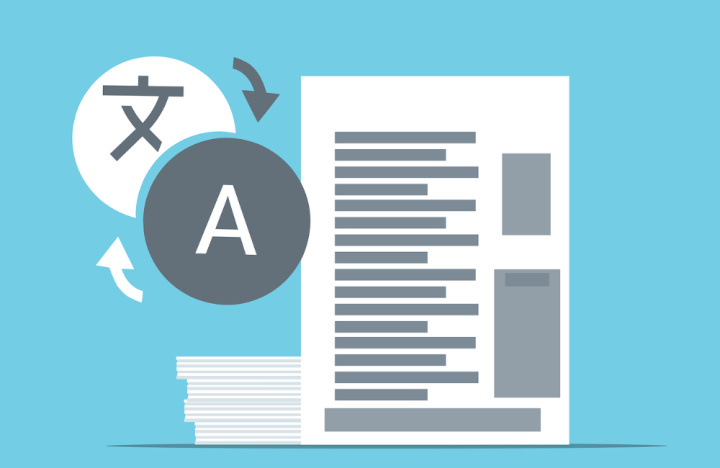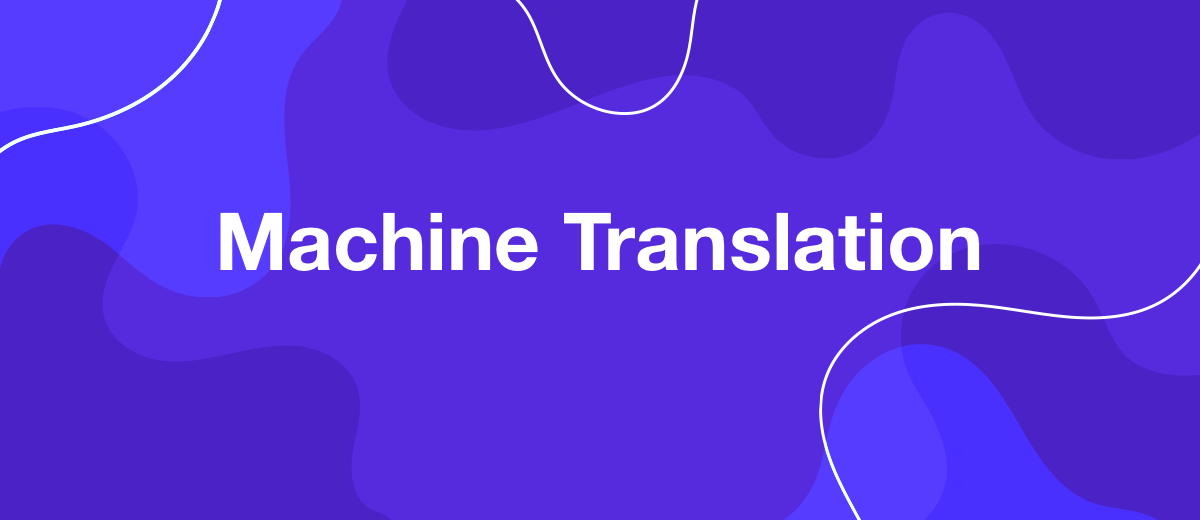What is Machine Translation and How It Works
Spheres of activity in which a person will not encounter information in a non-native language can be counted on the fingers. This applies not only to professional activities, but to everyday life. In addition, the volume of information in foreign languages is constantly growing.
Content:
1. What is machine translation
2. History of the machine translation
3. Statistics versus rule based translation
4. Neural networks to help
5. Machine translation in business
Neither the universal teaching of foreign languages, nor the increase in the army of translators make the situation easier. A different approach is needed, which arose in the middle of the 20th century and rapidly developing before our eyes – machine translation.
The changes that this technology brings to people's lives can be traced even in the memory of one generation. So, the author of these lines in his student years used Muller's thick dictionary. Without this it was impossible to imagine working with translations from Russian into English. At the beginning of the 21st century, I had already begun to download the first electronic dictionaries and translators from floppy disks to a personal computer. Even then, Muller's dictionary began to move to the edge of the bookshelf. Today I have instant translation from dozens of languages thanks to Google Translate. For some special occasions, I still keep a mobile dictionary application on my smartphone. When I was preparing this publication, I could not remember the last time I did a translation of the text I needed without the support of a computer “interpreter”. And a bulky, yellow dictionary has long been lost somewhere.
What is machine translation
In its most general form, "machine translation" (MT) is the translation of information presented in one language into another. The process is performed by a specialized computer program.
The word "machine" is quite correct to replace the word "automatic". But not "automated". The latter term means that the computer acts as nothing more than an assistant to a human translator. In English, the term Machine Translation (MT) is used for machine translation, machine-aided or machine-assisted translation (MAT) is used for automated translation.
Remember, above, I mentioned the mobile dictionary app on a smartphone? When you translate a quote from the New York Times based on your own knowledge of English, and refine individual terms in a mobile application, this is a very simplified example of automated translation.

Professional translators use different, very powerful CAT tools. As an example, I will mention SmartCat - a free cloud platform consisting of a memory of completed translations, a machine translation engine, and dictionary management tools.
Today, three types of MT coexist and compete:
- Statistical Machine Translation (SMT);
- Machine translation according to the rules (Rule-based Machine Translation, RBMT).
- Machine translation on neural networks (Neural machine translation, NMT)
Before discussing each type, it is useful to briefly review the history of machine translation.
History of the machine translation
MP technology is closely intertwined with the IT industry. It started in the second half of the 20th century. For the sake of historical accuracy, we note that in the 30s, mechanical devices for translation were patented in France and the USSR. But these devices did not have any influence on the further development of the MP.
The second half of the 20th century was marked by the rapid development of computer technology and programming. And, at the same time, the height of the Cold War with the arms race. Paradoxically, these, by no means negative phenomena, have become fertile ground for the development of scientific and technological progress. Including machine translation.
However, (before the beginning of the 2000s) the capabilities of hardware and the development of digital communications hampered the widespread use of machine translation. The last 15-20 years, on the contrary, have been marked by progress.
Here is a brief chronology of the development of machine translation methods:
- 1947 - Starting point for the development of the MP. The mathematician and decipherer Warren Weaver suggested that the "father" of cybernetics, Norbert Wiener, approach text translation as deciphering. “When I see a text in Russian, I tell myself that it is actually written in English and encrypted with strange characters,” Weaver wrote to Viner. “And I just need to decipher it.” Although Wiener met the idea without enthusiasm, it did not die out, but gave rise to the statistical method of MP.
- 1952 - First scientific conference on machine translation. The people gathered there were younger than those who went through the war, Wiener and Weaver. They knew little about deciphering enemy dispatches. But they knew that sentences are built according to certain rules. It was decided to put in the basis of translation programs. This was the beginning of machine translation according to the rules.
- 1954 - "Georgetown Experiment" - presentation of the first ever active MT program created by IBM and Georgetown University. The computer translated fifty sentences from Russian into English. The translation used a dictionary of 250 words and six grammar rules. Punched cards were used to enter text, and the result was output to a printer. Monitors and keyboards had not yet been invented.
- 1955 - The Soviet Union created its own machine translator
- 1964 - The US government establishes the Automatic Language Processing Advisory Committee (ALPAC). An important task was assigned to it - is it worth spending public money on this undertaking. In 1966, ALPAC decides that machine translation has no future. State funding ceased, and for almost a quarter of a century machine translation developed only in private companies. ALPAC's decision also affected the fate of technology on the other side of the Iron Curtain. In the USSR, machine translation was developed by enthusiasts.
- 1968 - Programmer Peter Thoma establishes Lastec, which creates one of the most successful machine translation systems - SYSTRAN.
- 1972 - The most "advanced" Soviet MT program of that time - ETAP ("Electrotechnical Automatic Translation") was launched.
- 1999 Pilot Japanese-English Simultaneous Translation Program introduced in Japan.
- 2000 - The first version of the machine translation system from Microsoft.
- 2006 - Google introduces its own translation tool Google Translate based on statistical MT. 2 years before, Google abandoned SYSTRAN and set its sights on creating its own translator.
- 2017 Google moves from the statistical method of MP to neural networks. Also introduced this year is Amazon Translate.
Statistics against rule based translation
We have already spoken about the types of MP. Let's talk in more detail about each of them, their advantages and disadvantages.
Let's start with machine rule based translation. It was this approach that was first put into practice during the Georgetown experiment. Machine translation according to the rules is based on linguistic data about the languages from which and into which the text is translated. The creators of the translation program need to match the dictionaries and grammars of the languages. After all, they determine the patterns of each language. Next, the text is converted into another language sentence by sentence.
The positive aspects of MP according to the rules are its accuracy in terms of syntax and morphology, stable and predictable results. This method of translation adapts well to a specific topic. The benefits are paid for by the laboriousness and time spent on creating the system, the constant updating of linguistic databases. Finally, experts draw attention to the "machine accent" that appears during translation.

The statistical type of MT is based on the search for the most probable translation of a sentence based on a comparison of a large number of language pairs (texts in which the same sentence is present in two languages). The advantage of statistical MT over translation according to the rules is a smoother translation. However, often the result of the work is very unpredictable.
- Automate the work of an online store or landing
- Empower through integration
- Don't spend money on programmers and integrators
- Save time by automating routine tasks
Also, statistical translation is inferior to a competitor in terms of required computing power. Rule based translation does not require a large amount of calculations and powerful computers. But at the same time it produces quite decent quality.
Neural networks to help
Machine translation began its development with the “rule based” method. With the growth of hardware capabilities and the use of cloud technologies, the statistical method has become the most common. However, in the last ten years, both of them began to give way to an approach based on the use of neural networks. The same Google in 2017 abandoned statistical in favor of neural translation (NMT).
This translation method is based on the use of neural networks. We remind the reader that a neural network is a special mathematical model and a hardware-software complex on which it is implemented. The neural network is based on the same principles as the complexes of nerve cells of living organisms. Where does the name actually come from. It would be quite correct to call HMT machine translation based on artificial intelligence. After all, this fashionable term is nothing more than a spectacular name for the use of neural networks.
The most important feature of a neural network is that it is not programmed to solve a problem, but is trained. That is, it unleashes the task after repeatedly solving other, similar tasks. In relation to the topic under discussion, a very useful feature of neural machine translation is that it requires much less computer resources than its competitors.
Experience has shown that neural machine translation performs a more natural translation (without the so-called "machine" accent). Alas, often a neural network can behave unexpectedly, start to “be smart”. The disadvantages of NMT also include the time required to train the neural network. Where it takes 1-3 weeks to train a neural model, tuning a statistical model takes several days. With the increase in the size of the neural network, this gap increases even more. And as the size increases, this difference increases even more.
On the other hand, NMT does an excellent job with short phrases. Therefore, if you use the same Google Translate, break the text to be translated into shorter phrases. Which, by the way, good writers have always done. Konstantin Paustovsky described what exactly this was done by a friend of his youth - Isaac Babel. The author of "Odessa Tales" repeatedly re-read the texts and mercilessly threw out unnecessary words and shortened sentences. I think Google Translate would have liked this approach.
More seriously, neural translation has become an excellent tool specifically for communicating in social networks and instant messengers, reading news or articles on Wikipedia, and navigator applications.
Machine translation in business
Discussing the relationship between machine translation and business, one should separate situations when translation itself is a means of making money and when translation is important, but just an additional tool in the company's work.
Machine translation risks
Let's start with translation as a business. Here are some numbers
- In 2021, the global market for translation services amounted to more than $50 billion (Statista data)
- 640 thousand people work in this area (data from the Translators Association of China)
- During the COVID-19 pandemic, the translation services market has grown by 40% (data from Market Research Future). According to CSA Research, the need for translation has grown the most in healthcare and pharmaceuticals (over 40%). At the same time, transfers decreased in the entertainment and tourism sector (more than 70%) and in the automotive industry (60%).
- In 2020, the global machine translation market was estimated at $650 million. In 2027, it could reach $3 billion (data from Global Market Insights).
Both professional translators and their clients have a very ambiguous attitude towards MT. Many translation agencies specifically indicate on their websites: “We do not allow machine translation!”

This situation simply reflects a misunderstanding by much of society about the scope of the tool. And the rejection of those who fear that technology will take away a piece of bread from them. Yes, machine translation is cheap and fast. But the quality of it in most cases is worse than the translation, so to speak, handmade.
There are those who openly offer such services and even indicate the cost of machine translation. The author found an NMP offer: UAH 650 for the translation of 8,000 characters (approximately a newspaper page) over three days.
Like it or not, the volume of tasks for the MT will increase rapidly. This was clearly shown by the coronavirus pandemic, when huge amounts of information related to COVID-19 needed to be translated.
So professional translators will have to put up with their computer competitor. After all, the lion's share of machine translations requires post-editing. Correction of errors, incorrect wording, stylistics - all these works will be in demand for many more years.
Machine translation - to every office
In everyday life, machine translation has already taken root. However, a business, especially a large-scale one, has different goals and requirements than an ordinary layman. When large companies create their own enterprise MT systems, the tasks that are assigned to developers look very severe. The system must cope with the translation of business correspondence and communication with clients, the localization of web resources, the integration of translation into business processes and software. This requires high accuracy with maximum confidentiality and security. It is difficult to say whether there is a similar system that would meet all such requirements.
At the same time, the tasks with which corporate MT systems cope quite successfully have already been determined. In particular, these are internal information materials (transmitting the essence of the text), product / product range for subsequent upload to web resources, data search in foreign publics. Spheres where the use of MP should be treated with extreme caution have also been identified. Among them - jurisprudence, marketing, PR, materials related to medicine and pharmaceuticals.
When considering pharmaceutical software development, pay attention to the regulations it should comply with. The pharmaceutical industry is strictly regulated, so your development partner should use the appropriate tech stack and have enough experience in this field to guide you through.
Machine translation, with a clear understanding of the possibilities and limitations, can become a useful tool both in everyday life and in business. But, like any technology, if used ineptly, it can disappoint and even cause rejection.
Apix-Drive is a universal tool that will quickly streamline any workflow, freeing you from routine and possible financial losses. Try ApiX-Drive in action and see how useful it is for you personally. In the meantime, you are setting up connections between systems, think about where you are investing your free time, because now you will have much more of it.


